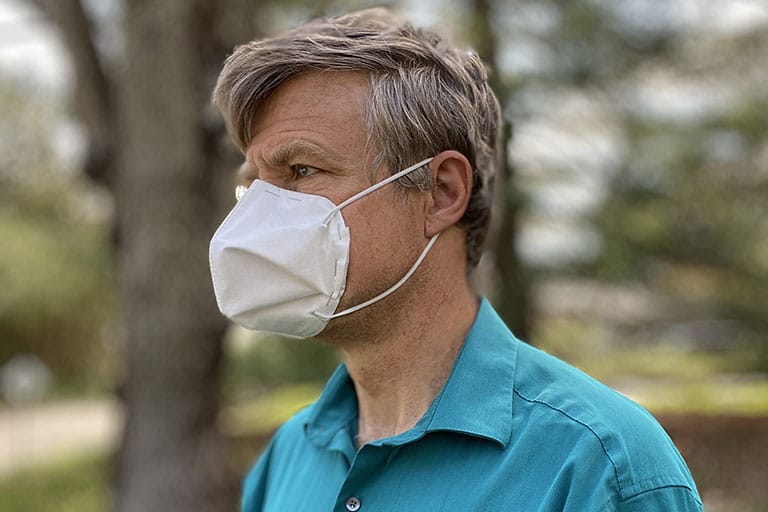You Can Make This No-Sew Origami Mask In Under Two Minutes

An example of the origami mask Image courtesy Jiangmei Wu
The CDC now recommends wearing face masks in public places like the grocery store or on public transit where it’s difficult to maintain the recommended six-foot distance. But if you aren’t a quilter or BFFs with one, you’re in luck—as long as you can fold a vacuum bag.
Jiangmei Wu, an assistant professor of interior design at Indiana University, devised a mask that can be made from foldable material like vacuum bags or the medical material Tyvek in under two minutes. All you need is a HEPA filter vacuum bag (Most HEPA bags don’t contain fiberglass, which means they can be safely used for DIY masks, but check the label to make sure), scissors, a twist tie, a stapler, two elastic strips, and this adult or child mask template (note: manufacturers of HEPA vacuum bags haven’t endorsed repurposing their products to make masks).
After tracing the template on the vacuum bag, mask-makers can follow along with Wu step by step in a two-minute YouTube video or download written instructions.
Wu says what sets her design apart is that it can be made quickly and features a tighter seal around the nose and mouth than most surgical masks. “Surgical masks are made from a very simple accordion fold,” she says. “But the human face has lots of curvatures — the cheeks, the nose bridge, the chin — and you need a fold that will allow a square piece of material to fit the face tightly.”

Jiangmei Wu demonstrating her maskImage courtesy Jiangmei Wu
Wu was inspired to create her mask after her brother, who lives in Hong Kong, asked in late January if she could ship him surgical masks—he thought she might still be able to find some in the U.S. since the coronavirus hadn’t yet spread widely here. She combed stores across Bloomington, but came up empty. So Wu, an internationally renowned origami artist, got to work. Her greatest challenge was finding the right material—she needed something that was breathable, yet effective at blocking the virus.
HEPA filter paper came out on top. “The HEPA material found in vacuum bags is the best everyday material at filtering out viruses,” she says. And her mask is more than a stopgap solution—tests at Missouri University and the University of Virginia have shown that vacuum bags remove between 60 and 87 percent of microscopic particles.
Wu says the adult and child patterns can easily be scaled up or down if the mask pinches or doesn’t fit tightly to the face. And if you don’t have filter paper, you can use fabric or another foldable material, although it will provide much less protection. She says masks made from HEPA filter paper may be reusable after a zap in the microwave to kill the virus, though she disposes of her own after a single trip to the grocery store or pharmacy.
Though Wu says her design isn’t intended for use by medical professionals, she hopes to eventually redesign the surgical masks used in operating rooms. “The design of surgical masks hasn’t changed for decades, and they only have a filtration efficiency ranging from 60 to 80 percent,” she says. “They’re designed to prevent surgeons from passing bacteria and viruses to patients, not the other way around. They’re not meant to be worn during a pandemic.”





